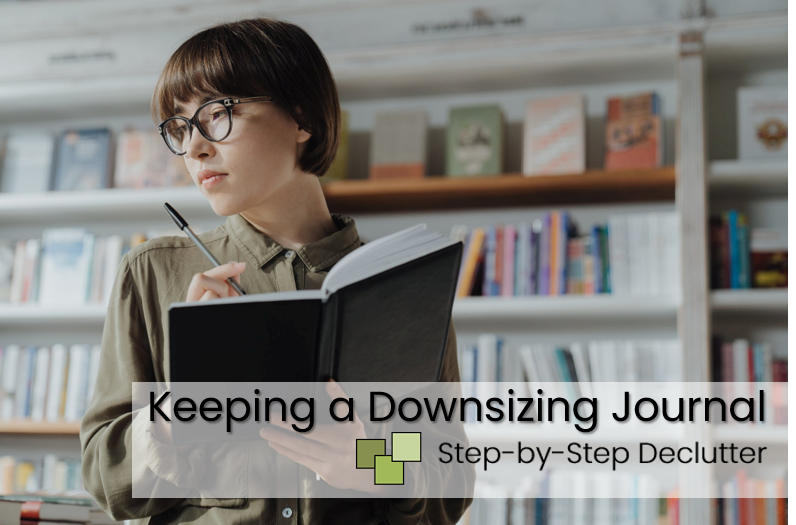|
|
Recently, as I have begun to work virtually with clients, I have encouraged them to keep a downsizing journal.
A downsizing journal is exactly what it sounds like: a journal dedicated to the process of downsizing. Downsizing is a major undertaking that involves a great deal of physical, mental, and emotional effort. At times, it can be overwhelming, frustrating, and/or exhausting. Staying on track and maintaining your motivation for such an undertaking can be challenging. Writing about the experience can help you appreciate your purpose, examine your feelings, vent your frustrations, and record your progress.
You can obviously include anything you like in your downsizing journal. That's the beauty of journals; they're personal. That said, I do have a few recommendations for how to utilize a downsizing journal effectively. Consider including the following: Define Your "Why" Your "why" is your purpose for downsizing. I enthusiastically encourage you to start your journal off by creating your persoanl list of reasons for embarking on the downsizing journey. Take your time producing this list. Ponder. Ask yourself questions such as:
Record your answers. You can create a simple bullet list or write detailed paragraphs explaining each of your reasons. However you choose to record the information, it's important that you look at it frequently throughout the process. Use it as a reminder of why you started the downsizing process and a source of motivation to keep you focused and moving forward. Describe Your End State Your end state is closely related to your "why" but different enough to merit a page or two of its own. Your end state is what allows you both to visualize and to recognize success. How will you know when you have successfully downsized if you don't have a picture in your mind of what that will look like? Again, it's helpful to ask yourself a few questions and record your answers. Some questions to ponder include:
Again, it's important to revisit your answers periodically in order to evaluate your progress and be reminded of what you are working toward. Outline an Action Plan If you are working with a professional organizer, he/she can assist you in creating an overarching plan for achieving your downsizing goals. Downsizing is a comprehensive process that typically involves editing all of your possessions, at least to a certain degree. As such, it is best to break it down. I recommend taking one of the following approaches:
Creating a detailed plan for downsizing will take some time and thought, but it will make the actual process much simpler because you will know when you have met your goal. Decision making will be less stressful if you have a clear set of guidelines in place to help you determine what you want/need to keep. Record Your Progress A journal is a great place to insert before and after photographs to document your progress. You might also use your journal to make to do lists. Personally I find crossing items off a list extremely satisfying. You can also just write about your progress in typical journal format by describing what you accomplish each day or week. Vent Your Frustrations As with any major undertaking you will encounter challenges throughout the downsizing process. Things will not always go according to plan. Venting your frustrations on paper can be wonderfully theraputic. It's a way of purging your soul while purging your belongings! Work Through the Decision Making Process If you're having trouble determining what to part with or struggling to let go of things, write about it. Make a list of pros and cons for keeping or getting rid of a particular item that's causing your stress. Seeing it all laid out in black and white often yields an obvious solution. Record Your Feelings When you're feeling overwhelmed by the sheer scope and scale of the process, write it out. When you're feeling proud of what you've accomplished, record those emotions. Writing down your feelings can be an effective way of processing them. The simple act of writing it down can help you to make sense of what you're feeling and deal productively with those emotions. Write About Your Stuff Do you have fond memories of a particular item? Whether or not you are keeping the item in question, I recommend writing about it. Describe the circumstances that led you to acquire the item, who gave it to you, what you love about it, why it has value to you, and where it came from. You might even experiment with writing to the item itself. Pretend you are transcribing a letter to the beloved item. Reminisce about how you "met", who "introduced you", what kinds of experiences you enjoyed together, and so forth. Be sure to include a photograph of the item as well. Keep Track of Things We downsized as part of a recent move. For us the process involved giving away many items to friends and family, donating items to charity, and selling some items. Because I was giving away a lot of things to a lot of different people, I kept an ever-evolving list of the items I had offered up, who had claimed them, and when/where the items would be handed off to their new owners. A downsizing journal is the perfect place to keep track of such information. If you're selling a lot of things, you can also use your journal to list each item, your asking price, your rock-bottom price, and other pertinent information.
If you are embarking on the downsizing journey, I hope you will consider keeping a downsizing journal. Doing so can help you manage, process, record, and preserve the process. Your downsizing journal can be private, or you can share it with a family member or trusted friend. If you are working with an organizer, I recommend you share portions of your journal with him/her as you deem appropriate.
10 Comments
3/15/2021 01:48:52 pm
This was a very much needed blog....the only thing I would add is if it meant a lot to the person, take a photo of the item you are getting rid of...just in case you want to "see it"again! You did mention photographing the process/progress which is a great idea too....Great blog!!
Reply
3/15/2021 02:54:56 pm
I agree that a photo of the beloved item is an important addition. Thanks for commenting!
Reply
3/15/2021 02:11:19 pm
I think we all process difficult things in our own way, and I can see that having a journal would be a very useful tool during the stress of downsizing. As you outline, it has both practical and emotional benefits, as you need it. Also, it allows you to keep everything in one place, which is always a good idea during chaotic times!
Reply
3/15/2021 02:57:49 pm
It’s so true that we all process things differently. I know that this method won’t work for everyone, but hopefully some people will find it useful. I used a modified version during our move, and it was super helpful to have all the information in one place.
Reply
3/15/2021 02:39:44 pm
There is much value to keeping a journal. I specifically like your suggestion to write down why you are downsizing. I am currently working on a workbook which helps with the downsizing process. Not so much a journal as a guide.
Reply
3/15/2021 03:00:10 pm
Thanks so much for your comment. Your workbook sounds brilliant. I would love to see it when it’s done.
Reply
3/15/2021 06:10:48 pm
As a longtime journal keeper, I love your idea of creating a downsizing journal. Several years ago, I cleared out and sold my parents' home, and then moved my mom into a memory care unit in an assisted living facility. Talk about downsizing! She went from a large house to being in a single room. It's amazing what she didn't need any longer. Because of her dementia, she wasn't aware of the moving and clearing out process. I was, and it was emotional. I didn't have a downsizing journal, but I did a lot of journaling and blogging about the process during that time. It was so valuable in helping me to work through emotions, celebrate, share, remember, and let go.
Reply
3/16/2021 08:50:58 am
Wow, Linda! Thanks so much for sharing your experience! Yours is exactly the kind of downsizing project I had in mind when I came up with the idea of a journal. I’m so glad to hear of a situation in which such a thing was/would have been helpful. There is so much emotion associated with this process, I really believe writing is an excellent way, at least for some, to work through a lot of the feelings and problem solve.
Reply
3/17/2021 02:14:03 am
I have never been able to keep a journal for more than a week (though I use daily emails with a friend such that the correspondence serves a similar purpose); however, I have recently started having my virtual clients keep track of their organizing and productivity progress through journaling. I think this post will really help them!
Reply
3/17/2021 09:11:20 am
Consistency is definitely a challenge when it comes to journaling. I thought it was interesting that you mentioned your emails with your friend as a substitute because that is something I have done as well. When my husband has been deployed, I have saved our messages in a sort of back and forth journal format to serve the same purpose because it felt like a waste of time to write much of the same information twice. I’m so glad you found this post helpful. I wish you luck with your virtual clients. I would love to hear how it goes.
Reply
Leave a Reply. |
Archives
November 2022
Categories
All
|
Proudly powered by Weebly




 RSS Feed
RSS Feed